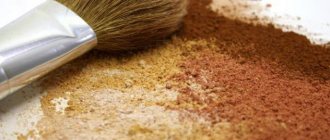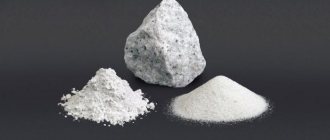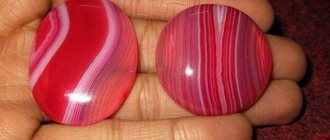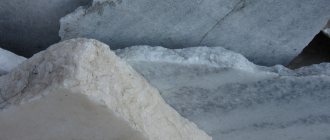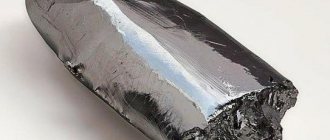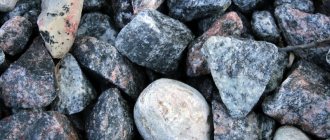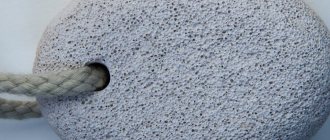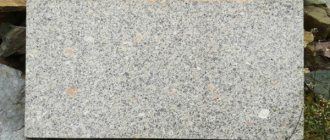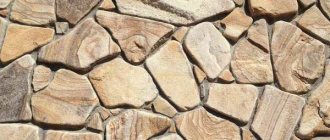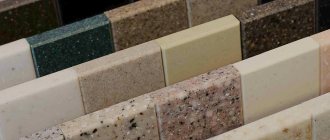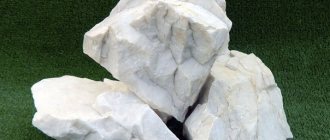What is talc? Talc is a silicate that has a layered structure, is greasy to the touch and has a pronounced pearlescent luster. It has a white color with various shades, which are determined by the impurities included in the composition (nickel, manganese, chromium, iron and aluminum). The intensity of the color is determined by the degree of purification.
Depending on the structure and existing impurities, the following types of talc mineral are distinguished:
- Agalite. It has a needle-like structure. The crystal fibers are located almost parallel, in the same direction.
- Minnesotaite. The presence of iron (it replaces magnesium) gives it a brownish tint.
- Steatite. Characterized by a dense structure. It is also called wen.
- Willemseit. Due to the presence of nickel, it has a bluish or greenish tint.
- Noble talc. A translucent stone with high density. Well processed.
- Soapstone chlorite. Contains chloride.
According to the degree of grinding, talc powder, microtalc and coarse grinding are distinguished. It has a standard hardness of 1. That is, it is the softest mineral. It was first discovered and described by Michael Faraday while studying dielectrics. It is mined in America, Canada, China, France and other countries. In Russia, the largest deposits are located in the Urals and Krasnoyarsk Territory.
Story
The properties of talc have been known and used since ancient times:
- Archaeologists have unearthed jewelry and scarab beetles made of stone that are seven thousand years old in Egypt.
- The Sumerians made seals from talc, and ancient craftsmen created cameos.
- An outstanding creation of the Orthodox world is an icon with the face of Demetrius of Thessalonica (11th century), carved in talcum powder.
The name of the stone under which it went down in history means “pure” in Arabic and Farsi.
This characteristic was noted by the great alchemist Gregory Agricola. The first written mention and description of talc is recorded in his works (1546). He called the mineral differently - soapstone, wen, soapstone, steatite.
PROPERTIES
Talc is a recognized standard of softness of natural materials. Color ranges from light apple green to white and silvery white, sometimes yellowish. The luster is greasy, pearlescent on the cleavage planes. The cleavage is very perfect. Translucent at the edges, transparent in thin leaves. The cleavage is very perfect according to (001). Hardness 1 (minimum) on the Mohs scale. Oily to the touch. Under the blowpipe it turns white and breaks up into small sheets; melts with difficulty, forming white enamel on the edges.
Physico-chemical characteristics
For chemists, talc is magnesium silicate with impurities. Sometimes they partially replace magnesium, creating independent types of stone.
| Formula | Mg3Si4O10(OH)2 |
| Color | White |
| Stroke color | white |
| Shine | Glass (pearl) |
| Transparency | Translucent |
| Hardness | 1 |
| Cleavage | Perfect by {001} |
| Density | 2.6—2.8 g/cm³ |
| singonia | Monoclinic |
| Refractive index | 1,58 |
According to the international nomenclature, the mineral class is silicate.
STRUCTURE
The mineral talc has a crystalline (usually rhombic) structure. In nature it occurs in the form of leafy granular layers. It is a secondary mineral that is formed when magnesium silicates, which do not contain aluminum (Al), change their chemical composition.
The crystal lattice of talc is formed by a layer of magnesium oxide, framed by two layers of non-polar tetraers of quartz and oxygen. The outer surface of the flakes contains neither hydroxyl groups nor active ions, which determines the high chemical resistance and hydrophobicity of talc. Three-layer talc crystals, having a very strong internal bond, are very weakly connected to each other.
Varieties
The following varieties of talc have been identified:
- Agalite. Fine fibrous mineral.
- Noble. Light or transparent in any color.
- Soapstone (wen) . Massive stones of dense texture.
- Willemseit. Green-blue talc.
- Minnesotaite. Ferrous red-brown, “rusty” specimens.
The shades of the last two varieties are created due to the partial displacement of magnesium from the composition of the mineral, respectively, by nickel and iron.
Minerals, mining
The origin of talc is dolomite - the impact of hydrothermal waters transforms dolomites into talc-containing rocks.
Types of minerals:
- willemseite;
- agalite;
- steatite (soapstone, soapstone);
- Minnesotait;
- noble talc; white, translucent, dense mineral, tolerates polishing and cutting well.
Talc minerals are mined all over the world.
For those who like to drink whiskey cold, but not diluted with ice: good bartenders have soapstone cubes in their freezer for this purpose. They are placed in a glass with a drink. We recommend: Application of SNOW QUARTZ
Where is it used?
Talc has found practical application and is in demand in the beauty industry and by collectors.
Industry
The mineral is used as a source material by most industries:
- Due to its acid- and fire-resistant properties, it is an additive to refractories and other similar products.
- Powdered mineral, purified from impurities, becomes baby powder and is included in tablet medications and dietary supplements.
- Manufacturers of cosmetics and perfumes use it to make a range of products with antiseptic properties (soap, solid deodorants, powder).
- Rubber gloves, inflatable toys, and balls are sprinkled with it to prevent them from sticking together.
- It is a component of ceramics for insulators, a filler in the production of rubber, paper, varnishes, and paints.
- Sports magnesium.
- Food additive E553b. They sprinkle it on candies and marshmallows to prevent them from caking.
However, the ground mineral requires caution when handling. Talcosis (pulmonary pathology) is an occupational disease of people who mine talc.
If talc microparticles get into the lungs or mucous membranes, it can lead to breathing problems, even cancer.
Household use
Soapstone is environmentally friendly, retains heat for a long time, and is fireproof. They are used to line steam rooms, baths, and stoves.
Household utensils are made from talc.
The purified mineral, ground to powder, is poured over shoes to avoid abrasions and diaper rash on the skin.
Powder
Decor
Master stone cutters love talc. It is beautiful, aesthetic, and easy to process. The assortment is wide - from small plastic to large carved panels.
Jewelry is made individually. The ultra-soft mineral is not suitable for inserting rings, rings, or bracelets. But it is suitable for pendants, pendants, earring inserts, and brooches.
Collecting
Collectors of mineral collections are interested in samples of pure minerals of different shades and combinations with other rocks. There are dozens of such samples.
ORIGIN
Talc is formed as a result of the interaction of dolomites and water from hot springs. Soapstones of various impurity composition are a consequence of the reactions of silicic acid decomposition of magnesian rocks.
Talc deposits are ubiquitous. However, only in Brazil are large (up to 5 cm) crystals of talc covered with a quartz crust found. The United States has remained the champion in industrial talc production for many years. Canada, France, Russia, and the countries of the Far East are famous for the development of high-quality talc.
In Russia, the Shabrovo talc-magnesite and Miass talcite deposits are being developed in the Middle Urals, the Onotskoye deposit of steatite (solid) talc (Eastern Sayan); The Western Baikal talconiferous province has been identified. Abroad, large deposits are known in Canada (Maidoc), USA (Gavernur), France (Luzenac), etc.
How to distinguish
A thousand years ago, the Chinese knew how to sell cheap colored talc under the guise of noble jade.
Today, imitation is also practiced:
- It is easy to distinguish one stone from another: the talc is scratched with a fingernail or a needle. Jade is not scratched by anything. Talcum powder leaves a white streak on the porcelain.
- But talc is also counterfeited, replacing the mineral with plastic. You can distinguish the origin by assessing the sample for massiveness. Talcum powder is always heavier.
When purchasing talc powder, pay attention to the manufacturer. For example, the Russian brand “Baikal Minerals” has a good reputation. It is positioned as a supplier of a clean, safe product.
What does talc treat and what is useful?
Talc has a generally beneficial effect on the human body. Powder made from the mineral is used mainly externally. Useful powder when used in moderation:
- absorbs sweat and reduces friction, helps prevent and eliminate skin rash;
- has a beneficial effect on prickly heat;
- cools the skin and eliminates itching and irritation;
- promotes softening and healing of the epidermis;
- allows you to keep your body fresh in hot weather;
- unclogs contaminated pores and helps regulate the functioning of the sebaceous glands;
- eliminates discomfort and unpleasant odor due to excessive sweating of the feet.
The powder is used for massage - it acts like a soft scrub, removes dead particles of the epidermis and creates slip. Choosing talc instead of oily mixtures is especially recommended if you have a lot of body hair. The powder is used for wax depilation of excess vegetation. The body skin is treated with talc before and after the procedure - this helps prevent irritation and protects against ingrown hairs.
Talcum powder does not stain clothes and this compares favorably with most deodorants
Unexpected uses
Plant lovers, by the way, also have this wonderful remedy in their arsenal. You'll never guess what they use body talc for!
For plants
To save flower bulbs from rotting and various diseases, they sprinkle them with that same powder.
From stains
Why else would there be talc in your home?
For example, to urgently save an item that has a stain from cosmetics or oil. Stains need to be treated with powder, and then the rest must be removed with a spoon or napkin. By the way, here's why you need this body powder:
It can be used to neutralize yellow stains from sweat on white fabrics.
To do this, pour powder onto the stain and iron it through a damp cloth. A somewhat unusual use of talcum powder for the body, but very practical.
For textiles
If you urgently need to refresh the textiles in your room, sprinkle it with this powder. Only for such purposes it is important to use perfumed talc, for example, “delicacy of sandalwood”, with a vanilla aroma or with notes of jasmine and citrus.
I almost forgot to share: how to open a tube if it is sealed with plastic from the inside. Carefully turn the lid and in places where holes are visible under the film, simply pierce the protective layer with a thick needle.
Acidity
To 2.5 g of the substance add 50 ml of water free of carbon dioxide and reflux for 30 minutes. After cooling, the solution is filtered under vacuum. To 10 ml of filtrate add 0.1 ml of 0.04% solution of bromothymol blue; when adding no more than 0.4 ml of 0.01 M hydrochloric acid solution, a green color should appear.
To 10 ml of filtrate add 0.1 ml of 1% phenolphthalein solution; when adding no more than 0.3 ml of 0.01 M sodium hydroxide solution, a pink color should appear.
Substances soluble in water
No more than 0.2%.
To 10 g of the substance add 50 ml of water free of carbon dioxide and reflux for 30 minutes. After cooling, the solution is filtered through a paper filter into a 50 ml volumetric flask, the volume of the solution is adjusted to the mark with water free of carbon dioxide and mixed. 25 ml of the filtrate is evaporated to dryness, the precipitate is dried in an oven at a temperature of 105 ºC for 1 hour and weighed. The mass of the residue should not exceed 10 mg.
